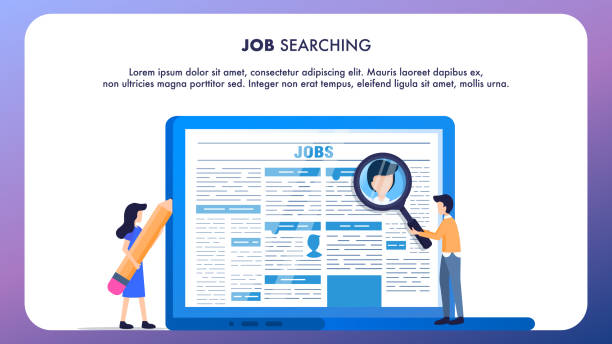Introduction to the Dynamic World of Web and the Importance of Responsive Design

In the current era, where smartphones, tablets, and various displays have become an inseparable part of our daily lives, the importance of Responsive Web Design becomes more evident than ever.
This #innovative approach in #web_design allows websites to automatically adjust their size and layout to the different dimensions of the user’s screen.
Users no longer need to zoom or perform unnecessary horizontal scrolling to view your site on various devices.
The main goal of responsive design is to provide a seamless and optimized user experience for all visitors, regardless of the type of device they use.
This approach not only leads to greater user satisfaction but also plays a vital role in maintaining and increasing your site’s traffic.
Today, a large portion of internet traffic comes from mobile devices, and ignoring this segment of users means losing countless opportunities.
In fact, Google has explicitly stated that it gives higher priority to responsive websites in its search ranking results, which itself confirms the undeniable importance of this type of design.
For any business that wants to have an effective and dynamic online presence, implementing a website with responsive design is no longer an option, but a necessity.
This transformation has revolutionized our understanding of accessing information and interacting with content.
How much does losing business leads due to an unprofessional website cost you? Solve this problem forever with professional corporate website design by Rasaweb!
✅ Increase credibility and trust of potential customers
✅ Easier acquisition of new business leads
⚡ Get free consultation now!
Fundamental Principles and Building Blocks of Responsive Web Design

Behind every website with responsive design, there is a set of technical principles and advanced techniques that make this flexibility possible.
The three main pillars of this approach include Fluid Grids, Flexible Images, and Media Queries.
Fluid Grids mean that instead of defining fixed dimensions based on pixels, relative units like percentages are used for element widths.
This allows the website layout to automatically change with the screen size.
Flexible images are also configured using CSS to display correctly in different spaces while maintaining their aspect ratio, preventing them from overflowing or shrinking too much.
But perhaps the most important element is Media Queries.
This CSS3 capability allows developers to apply different styles for various screen conditions, such as specific width, orientation (portrait or landscape), or even resolution.
For example, it can be determined that on smaller screens, the navigation menu transforms into a hamburger button, or text columns are stacked vertically instead of being side by side.
This specialized approach allows web designers to have precise control over how content is displayed on various devices and ensures that no user has an unpleasant experience.
The correct application of these principles requires a deep understanding of HTML and CSS, as well as familiarity with the performance of different browsers and devices.
Responsive web design is more than a simple technique; it is a design philosophy that embraces the dynamism of the web.
Popular Tools and Frameworks in Responsive Design

To facilitate the process of responsive web design, numerous tools and frameworks have been developed that have significantly simplified the work of developers.
These frameworks provide a set of pre-written CSS and JavaScript files that include responsive grids, UI components, and utility tools for quickly and efficiently building adaptive websites.
One of the most popular and widely used frameworks is Bootstrap.
Bootstrap, with a 12-column grid system and numerous ready-made components such as buttons, forms, navigation bars, and cards, allows developers to quickly build responsive websites.
Another framework with its own dedicated followers is Foundation, which adopts a “mobile-first” approach and offers high flexibility.
Choosing the right framework depends on the project’s needs and the developer’s preferences.
Some of these frameworks are also combined with other tools, such as CSS preprocessors (like Sass or Less), which allow for better style management and increased productivity.
Below, you will see a table of the most popular frameworks and their key features:
| Framework Name | Key Features | Approach | Community Support |
|---|---|---|---|
| Bootstrap | 12-column grid system, diverse UI components, JavaScript Plugin | Desktop-First (with Mobile-First capabilities) | Very extensive and active |
| Foundation | Mobile-First, high customization capability, Email Framework | Mobile-First | Active and UX-focused |
| Bulma | Based on Flexbox, CSS-Only, modular and lightweight | Mobile-First | Growing |
| Tailwind CSS | Utility-First, unparalleled flexibility, smallest final file size | Utility-First | Very popular and active |
These tools have transformed the development of responsive web design into a faster and more efficient process, such that even novice developers can build fully responsive and professional websites.
This expert guide will help you make a better choice.
The Importance of User Experience (UX) in Responsive Web Design

User Experience (UX) is the cornerstone of any successful website design, and in responsive web design, this importance is doubled.
A properly responsively designed website provides a smooth, pleasant, and hassle-free user experience, regardless of screen size.
This means that all elements, from text and images to buttons and forms, should be easily viewable and interactive on any device.
When users don’t need to zoom, horizontally scroll, or struggle to find information, they will feel more satisfied, and the likelihood of their returning to your site and converting into customers increases.
For instance, navigation menus should appropriately change (e.g., to a hamburger menu) on smaller devices to optimize screen space, and forms should be large enough to be easily filled with fingers.
The main goal of responsive web design is to adapt content to the user, not force the user to adapt to the content.
This is an explanatory and very fundamental approach for any web designer.
Ignoring UX in responsive design can lead to high bounce rates, decreased user engagement, and ultimately, damage to your brand.
Conversely, investing in a thoughtful responsive design that prioritizes user experience not only increases customer satisfaction but also significantly helps improve SEO and increase site traffic.
This synergy between responsive design and UX is the key to success in today’s digital ecosystem.
Does your current e-commerce website design lead to losing customers and sales?
Rasaweb is your solution with modern and user-friendly e-commerce website designs!
✅ Significant increase in conversion rates and sales
✅ Strong branding and building customer trust
⚡ Get a free e-commerce website design consultation from Rasaweb!
Challenges and Solutions for Implementing Responsive Design

Although responsive web design offers numerous advantages, its implementation is not without challenges.
One of the biggest challenges is managing content and visual elements across various screen dimensions.
An image might look stunning on a desktop but be too large or too small on a mobile device, requiring specific optimization.
Another challenge is ensuring proper performance across different devices, especially on smartphones with slower internet connections.
To address these challenges, several solutions exist.
For images, techniques like “Responsive Images” using srcset and sizes attributes in HTML5 or image CDN tools can be utilized, which automatically adjust image sizes based on the user’s device.
For performance improvement, code minification, image optimization, and using lazy loading techniques for off-screen content are highly effective.
Furthermore, there is the challenge of testing and debugging across multiple devices.
Browser developer tools (such as Chrome DevTools) have the ability to simulate various devices, which helps designers test responsiveness in diverse environments.
However, the best solution is to test on actual devices.
Ultimately, precise planning from the initial stages of the project and adopting a “mobile-first” approach in design can resolve many of these challenges before they occur.
This is not a questionable content, but a precise analysis of the workflow.
The Future of Web Design and the Indispensable Role of Responsiveness

The future of web design is inextricably linked with the concept of responsive web design.
With the advent of new technologies such as Augmented Reality (AR), Virtual Reality (VR), and the Internet of Things (IoT), displays and user interfaces will become far more diverse and ubiquitous.
From smartwatches to car displays and even smart mirrors, each requires a compatible web experience.
This is where the importance of responsiveness becomes even clearer.
Websites must be able to adapt their content not only to different dimensions but also to various interaction and input methods.
The trend towards “mobile-first” and even “content-first” designs indicates a paradigm shift in how designers think.
The focus is no longer solely on desktop appearance, but rather optimizing the experience for the smallest screen and then scaling it up for larger displays has become a priority.
Furthermore, Artificial Intelligence and Machine Learning can also play a significant role in responsive web design in the future, for example, by predicting user needs based on their device and behavior and automatically adjusting the user interface.
In this journey, the concept of “Adaptive Design” also stands alongside responsive design, with the difference that adaptive design loads specific versions of the website based on device detection, while responsive design changes fluidly.
However, the core focus will always be on providing a flawless user experience on any platform.
This analytical perspective helps us prepare for future challenges.
SEO and the Amazing Impact of Responsive Web Design

In today’s digital world, SEO (Search Engine Optimization) is the most vital factor for online visibility, and fortunately, responsive web design plays a very important role in improving your site’s ranking in search results.
Google has clearly stated that it prioritizes responsive websites in its rankings, especially with the introduction of “Mobile-First Indexing”.
This means that Google first considers the mobile version of your website for indexing and ranking.
A responsive website presents the same content with a single URL across all devices.
This makes it easier for search engine crawlers to crawl and index your site’s content without encountering duplicate content or multiple URLs for mobile and desktop versions.
This helps prevent duplicate content issues and keeps SEO power concentrated.
Furthermore, responsive web design leads to improvements in important UX factors such as lower bounce rates and longer time spent on the site, which also indirectly positively affect SEO.
Websites with poor mobile user experience typically experience high bounce rates, sending a negative signal to search engines.
For better understanding, pay attention to the table below, which shows the key differences between responsive and non-responsive websites from an SEO perspective:
| Feature | Responsive Website | Non-Responsive Website |
|---|---|---|
| URL | Single URL for all devices | Usually separate URLs (e.g., m.example.com) |
| Crawling and Indexing | Easier for Google crawlers (Mobile-First Indexing) | May lead to duplicate content and crawling complexity |
| Loading Speed | Usually optimized for mobile | May be slower on mobile |
| User Experience | Optimized on all devices, lower bounce rate | May be poor on some devices, high bounce rate |
| Google Ranking | Higher priority in ranking, especially for mobile searches | May be penalized in mobile search results |
Therefore, responsive web design is not merely a choice for visual aesthetics, but a strategic necessity for SEO and online success.
Case Studies of Success in Implementing Responsiveness

There is ample successful evidence demonstrating how responsive web design can revolutionize a business’s online presence.
Success stories from large corporations to small businesses emphasize that this approach brings tangible results in increasing traffic, improving conversion rates, and enhancing customer satisfaction.
One classic example is the Google Search website.
Although it seems simple, Google was one of the first and best examples of responsive design that maintained a consistent and flawless search experience on every device.
Another example is large news sites like The New York Times.
These sites, with a vast amount of content, had a crucial need for responsiveness so that users could easily read the latest news on their phones.
By implementing responsive web design, they were able to reach millions of mobile users and significantly increase user retention time.
Even in the e-commerce industry, companies like Amazon or eBay have invested heavily in responsiveness.
This approach has allowed them to keep the mobile shopping process as easy as on desktop, significantly increasing sales through mobile devices as a result.
This is not a news content, but a case study analysis demonstrating how companies have achieved success with this approach.
These cases prove that responsive web design is a smart investment with high returns.
Don’t have a corporate website yet and missing out on online opportunities? With professional corporate website design by Rasaweb,
✅ Double your business credibility
✅ Attract new customers
⚡ Get a free consultation for your corporate website!
Key Tips for Web Developers in Responsive Design

For developers intending to enter the world of responsive web design, observing several key tips can facilitate the process and lead to better results.
First and foremost, always design with a “Mobile-First” approach.
This means first designing the layout and user experience for the smallest screen, and then gradually scaling it up for larger displays.
This method ensures that the core content and functionality work well across all devices.
Second, use Media Queries logically and efficiently.
Avoid breaking the layout at every possible pixel; instead, choose breakpoints (Breakpoints) based on content and design needs.
Using relative units like em, rem, vw, vh, and percentages instead of fixed pixels for fonts and element dimensions increases the flexibility of your design.
Third, take image optimization seriously.
Large and unoptimized images can drastically reduce site loading speed, especially on mobile.
Using appropriate image formats (like WebP), compression, and lazy loading (Lazy Loading) for off-screen images is essential.
Fourth, don’t forget to test.
Use browser tools to simulate devices, but always test the final design on real devices, including smartphones and tablets with different operating systems.
This educational guide will help you identify and resolve potential issues before launch.
Finally, staying updated with the latest technologies and standards in responsive web design is crucial, as this field is rapidly changing and evolving.
Frequently Asked Questions and Final Conclusion on Responsive Design

Given the increasing proliferation of internet-connected devices and display diversity, understanding responsive web design and its principles is essential for anyone active in the web space.
In this section, we address some frequently asked questions and then provide a final conclusion.
Is responsive design only for mobile?
No, responsive web design goes beyond mobile.
Its goal is compatibility with any screen size, from the smallest phones to the largest smart TVs and wide desktop monitors.
This approach allows your website to display correctly in any environment.
Is building a responsive site more expensive?
Initially, it might require a greater upfront investment compared to building a static site or having separate mobile and desktop versions, but in the long run, due to easier maintenance (a single codebase), improved SEO, and better user experience, it is much more cost-effective.
How long does it take to build a responsive site?
The time required depends on the project’s complexity, the amount of content, and the features needed.
However, by using existing frameworks and tools, the development process can be accelerated.
In conclusion, responsive web design is no longer a luxury trend but an industry standard and a requirement for survival in today’s competitive web space.
This approach not only optimizes user experience and increases customer satisfaction but also directly impacts your search engine rankings and ultimately helps grow your business.
The future of the web is unimaginable without responsiveness.
Frequently Asked Questions
| Question | Answer |
|---|---|
| What is Responsive Web Design? | It is a method for designing and implementing websites that causes the layout and content of the screen to automatically adjust and display optimally based on the user’s device screen size (desktop, tablet, mobile, etc.). |
| Why is responsive design important? | With the increasing use of various devices to access the web, site responsiveness improves user experience, reduces bounce rate, strengthens site SEO, and makes site management and maintenance easier (instead of having separate versions for mobile and desktop). |
| How does responsive design work? | This type of design uses techniques such as flexible grids and layouts (Flexbox, CSS Grid), flexible images and media, and most importantly, CSS Media Queries to change the page styles and layout based on screen characteristics (width, height, resolution, etc.). |
| What are the main tools for implementing responsive design? | The main tools include HTML5 (for content structure), CSS3 (especially Media Queries, Flexbox, Grid for styling and responsive layout), and sometimes JavaScript for more complex interactions. |
| What are the main benefits of using responsive design? | The main benefits include increased user accessibility (covering a wide range of devices), improved user experience, improved site ranking in search engines (especially Google), reduced development and maintenance costs, and increased visitor-to-customer conversion rates. |
And other services of Rasa Web Advertising Agency in the field of advertising
Smart Google Ads: Professional optimization for campaign management using real data.
Smart Link Building: Professional optimization for customer behavior analysis using intelligent data analysis.
Smart Brand Identity: An effective tool for user interaction with the help of intelligent data analysis.
Smart Data Analysis: A creative platform for improving SEO ranking by managing Google ads.
Smart Marketing Automation: A new service for increasing digital branding through SEO-driven content strategy.
And over hundreds of other services in the field of internet advertising, advertising consultation, and organizational solutions
Internet Advertising | Advertising Strategy | Advertorial
Resources
What is Responsive Website Design and Why is it Important?Benefits of Responsive Design for Your BusinessAll About Responsive Website DesignComprehensive Guide to Implementing Responsive Website Design
? Rasaweb Afarin Digital Marketing Agency specializes in elevating your business in the online space. From fast website design and professional SEO optimization to managing advertising campaigns, we pave the way for your digital success.
📍 Tehran, Mirdamad Street, next to Central Bank, Southern Kazeroun Alley, Ramin Alley, No. 6



